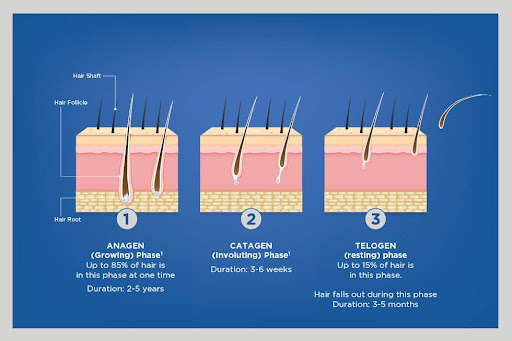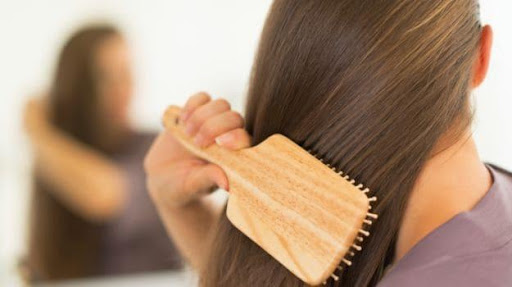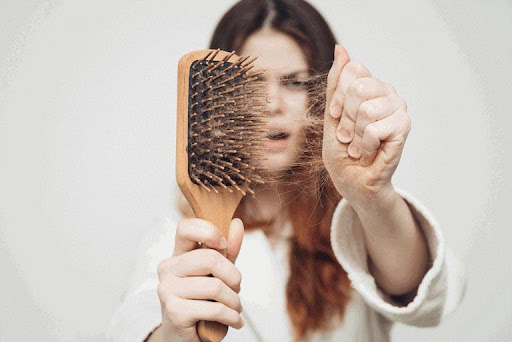If you’re here, you’ve probably already spent an hour panicking online while searching for ways to make your hair grow quicker and perusing comfortless medical websites. Maybe you recently gave yourself a regretful at-home haircut and are now seeking for techniques to grow your hair faster within a week, or maybe you’re convinced your hair is looking thinner after nervously inspecting your hairline in the mirror.
An average person loses 50–100 hairs per day. Because new hair is growing at the same time, this is typically not evident.
How Fast Does Your Hair Grow?
The exact rate of hair growth varies from person to person, therefore it’s difficult to say! According to a study, “human hair grows at a pace of 0.35 mm per day, and approximately 100 hairs are shed each day. It is common for hair to grow as little as a centimetre or as much as an inch in a month, despite this.”
Numerous factors, some of which you can manage and others which you can’t, can affect hair development. Genetics control how quickly hair grows, but other factors might also have an impact. Age, food, stress, hormonal changes, scalp health, hair care routines, and other medical issues may have an impact on hair growth.
Even though males typically grow their hair more quickly than women do, this can change during pregnancy. Hair growth rates can vary depending on the time of year.

Hair Growth Stage:
Understanding the hair growth cycle can help you appreciate why consistency in hair care is so important.
Anagen: The active phase of the hair cycle is anagen. The cells in the hair’s root are dividing quickly, leading to continuous growth. This phase can last anywhere from two to seven years.
Catagen: Approximately 3% of all hairs are always in the catagen phase, which is a transitional stage. During this short phase (around 2-3 weeks), hair growth stops, and the outer root sheath shrinks and attaches to the root of the hair.
Telogen: Telogen is the resting stage, which typically comprises 6% to 8% of all hairs. This phase lasts about 2-4 months. At the end of the telogen phase, the hair is shed, and a new hair begins the anagen phase.
How Do You Make Your Hair Grow Faster?
Your hormones, health, genetics, and age all have an impact on how quickly your hair grows. There is therefore no topical product that may make your hair grow longer and faster, despite what marketing and product labels may claim unless, of course, Your body has a disease or vitamin deficiency that, if treated, can cause hair to grow.
Having said that, for hair growth to function at its best, a healthy scalp, body, and hair habits are necessary. Continue reading to learn how to specifically create the best hair-growth condition and what simple steps you can apply in life for maintaining the best hair care.

Essential Hair Care Practices
1) Avoid shampooing every day:
Shampooing your hair every day might dry out and harm your hair unless it is oily. By only washing your hair every other day, the natural oils in your body can condition your hair. To assist in keeping your hair follicles clean, you might also think about utilising a scalp treatment. Your hair may remain healthy as a result of this.
2) Use Conditioner:
Make sure to condition your hair after shampooing. Your hair’s lost oils from shampooing can be replenished with the aid of a hair conditioner. Before conditioning your hair, make sure the shampoo is entirely removed.
3) Minimize the Use of Heat & Color:
Your hair will eventually become damaged if you use heat or hair colour on it. Try to let your hair air dry as frequently as you can to use less heat on it. Use velcro or sponge rollers as opposed to hot rollers. To lessen hair-dye damage, space out your colouring appointments and use a colour-safe shampoo.
4) Massage The Scalp:
The daily massage of your scalp may help to improve blood flow to your hair follicles and promote hair growth. As part of your everyday hair care routine, massage your scalp. Use gentle pressure with your fingertips. You can even incorporate a scalp massager for an enhanced experience.
5) Use a silk pillowcase:
A cotton pillowcase’s threads can entangle your hair. This friction is decreased by a silk pillowcase, which also decreases breakage. You might use a silk scarf instead of a silk pillowcase to cover your head.
6) Avoid wrapping your hair in a towel:
After taking a shower, covering your head with a towel might also weaken your hair. Instead, carefully blot the excess water out of your hair or squeeze it out. Given that microfiber towels are softer than traditional cotton towels, you can also think about using one to wrap your hair.
7) Learn to Love Low Ponytails:
While you can still style your hair, stay away from tight styles. Instead, stick with a simple style like a low ponytail (here are some suggestions) or be sure to choose hair accessories like silk scrunchies that won’t harm your hair.
8) Include Minerals in Your Diet:
Keratin, a type of protein, makes up the majority of your hair, nails, and skin. Protein-deficient hair enters the resting state earlier than protein-rich hair. The creation of the proteins that make up your body’s hair depends on minerals like iron and zinc. Hair loss is also a known side effect of low iron. Good sources of iron include lean red meat, spinach, lentils, and fortified cereals. Zinc can be found in nuts, seeds, legumes, and meat.
9) Eat vitamin-rich foods:
It is believed that vitamin D is essential for hair development, with studies suggesting its role in stimulating hair follicles. For the body to absorb iron, vitamin C is also crucial. Citrus fruits like oranges, grapefruit, and limes are rich in vitamin C. The sun and food sources like fortified milk and orange juice are two good sources of vitamin D. Other vital vitamins include B vitamins, particularly biotin, which supports keratin infrastructure, and Vitamin E, an antioxidant that can help protect hair follicles from damage.

Advanced Approaches and Latest Innovations in Hair Growth
While basic hair care and nutrition are fundamental, recent advancements offer additional avenues for those seeking to enhance hair growth.
Topical Treatments and Serums:
Beyond basic conditioners, many modern hair products are formulated with ingredients specifically designed to stimulate hair growth or reduce hair fall. Look for ingredients like:
-
Minoxidil: An FDA-approved over-the-counter treatment that directly stimulates hair follicles and prolongs the anagen (growth) phase. It’s often used for androgenetic alopecia (pattern baldness).
-
Peptides: Certain peptides can signal cells to produce more hair-growth factors and improve scalp circulation.
-
Caffeine: When applied topically, caffeine has been shown to stimulate hair growth by blocking the effects of DHT, a hormone linked to hair loss.
-
Rosemary Oil: Studies suggest rosemary oil can be as effective as minoxidil for some types of hair loss, due to its ability to improve circulation and promote cell turnover.
-
Biotin (topical): While oral biotin is common, topical applications are also being explored for their direct effect on the scalp.
-
Niacinamide (Vitamin B3): Can improve scalp barrier function and circulation.
Low-Level Laser Therapy (LLLT):
This non-invasive treatment uses specific wavelengths of light to stimulate hair follicles, reduce inflammation, and promote circulation in the scalp. LLLT devices are available for home use (like laser combs or caps) and in clinic settings. While results vary, it’s considered a safe option for many individuals experiencing hair thinning.
Platelet-Rich Plasma (PRP) Therapy:
A more advanced, clinical procedure, PRP involves drawing a small amount of your blood, processing it to concentrate the platelets (which are rich in growth factors), and then injecting the PRP into your scalp. These growth factors are believed to stimulate dormant hair follicles and encourage new hair growth. While promising, it typically requires multiple sessions and is a more significant investment.
Hair Growth Change After Pregnancy
Pregnant women could notice that their hair is growing more quickly. This is due to higher estrogen levels during pregnancy, which keep more hair follicles in the active anagen growth phase. New mothers, however, may feel as though they are losing their hair more quickly than usual. This is a common phenomenon known as postpartum hair loss or telogen effluvium. After delivery, estrogen levels drop, causing a large number of hair follicles to enter the dormant telogen phase and then shed simultaneously. This shedding usually peaks around 3-6 months postpartum and typically resolves on its own within a year.
Summary:
An average person loses 50–100 hairs per day. Human hair grows at a pace of 0.35 mm per day, and approximately 100 hairs are shed each day. Your hormones, health, genetics, and age all have an impact on how quickly your hair grows. For hair growth to function at its best, a healthy scalp, body, and hair habits are necessary. Avoid shampooing every day and air dry your hair as often as possible.
Minimize the use of heat and colour on your hair by using velcro or sponge rollers. Pregnant women could notice that their hair is growing more quickly after giving birth. The hormone oestrogen makes you have more hair follicles in the growth phase of pregnancy. Vitamin D is essential for hair development and eating vitamin-rich foods is a good source of iron.



